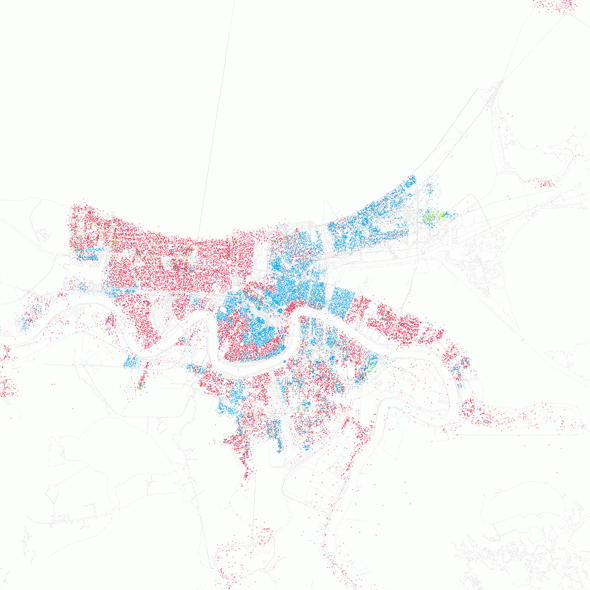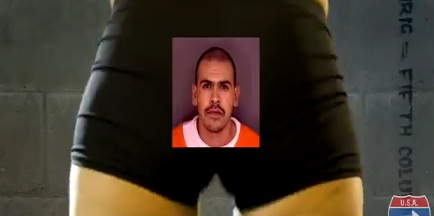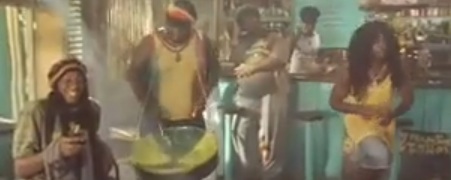Cross-posted at Caroline Heldman’s Blog.
Essence Music Festival, the “party with a purpose,” is a three-day event in New Orleans, featuring speakers during the day and musical performances at night. It also caters to an almost exclusively black audience, bringing 400,000 people to the Crescent City each year. Their sheer presence challenges informal systems of segregation in New Orleans.
After the show, I walked through the French Quarter with a few friends and noted how unusual it is to see so many black people in this part of town. Despite losing 118,000 black residents after Katrina, New Orleans is still a majority-black city, but highly segregated and even more so after Katrina. Formal and informal “policing” generally keeps black locals out of the touristy French Quarter, with the exception of Black residents who work/entertain there.
You can see just how segregated in this map by Eric Fischer (each dot is 25 people; red = White residents, blue = Black residents, and Green = Asian residents):
I first learned about this informal segregation a few years ago when I convinced my reluctant friend, Earl, to go to the Cat’s Meow on Bourbon Street for karaoke. A few blocks from our destination, Earl lagged behind for a moment, distracted by a cat painting, and a group of white locals “warned” me that I was about to “get jumped” by the black guy behind me. Once on Bourbon, we were there for less than a minute before a police officer approached us, questioned Earl’s reason for being there, and told us both to leave.
Policing also occurs in “black neighborhoods” in New Orleans. Working and living in the Seventh, Eighth, and Ninth Wards, my white students and I have been stopped more times than I can count by NOPD, other law enforcement, and “friendly” white people who question why we are in these neighborhoods (or as one member of the National Guard called the Seventh Ward, “Ghettoville USA”).
With the Essence Festival in town, it was refreshing to see many black faces around the French Quarter over the weekend, enjoying the most enriching nightlife in the country. But not everyone saw it this way.
An acquaintance told me her white roommate stayed in all weekend because the Essence Festival was in town and she didn’t want to “get shot.” A white friend who works as a server in the French Quarter told me she was happy when the Essence Festival was over because she wouldn’t have to hear all the racist comments from her fellow servers and her boss. While these white residents live in a majority-black city, they feel threatened when black people come from out of town and don’t follow the rules that keep local blacks in “black neighborhoods.”
Then came the news that a New Orleans Police Department Commander was reassigned pending an investigation of instructions he gave to officers on Friday night when deploying them into areas catering to Essence Festival visitors. He allegedly instructed them to single out young, black men, although the exact language he used has not been released. It’s worth mentioning that Essence has never had an incident of violent crime during its seventeen years, and (now former) Mayor Ray Nagin reported that there is less crime in the city during the festival.
The presence of hundreds of thousands of black people from other parts of the county who don’t know the unspoken rules of racial segregation in New Orleans exposes both these rules and the pernicious racism that undergirds them.
————————
More maps from Eric Fischer.
Also on residential segregation, see our posts on how it leads to uneven rates of asthma, lead poisoning, and exposure to toxic release facilities. But we blame poor people anyway.








